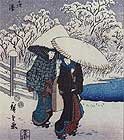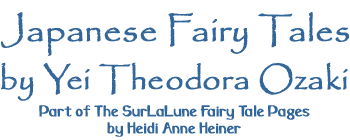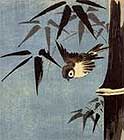


Japanese
Fairy Tales
by Yei Theodora Ozaki
Preface
The Story of Urashima Taro, the Fisher Lad
The Shinasha, or the South Pointing Carriage
The Adventures of Kintaro, the Golden Boy
The Story of the Man Who Did Not Wish To Die
The Bamboo-Cutter and the Moon-Child
The Sagacious Monkey and the Boar
The Happy Hunter and the Skillful Fisher
The Story of the Old Man Who Made Withered Trees To Flower
The Quarrel of Tee Monkey and the Crab
The White Hare and the Crocodiles
The Story of Prince Yamato Take
Momotaro, or the Story of the Son of a Peach
The Stones of Five Colors and the Empress Jokwa
Preface
This collection of Japanese fairy tales is the outcome of a suggestion made to me indirectly through a friend by Mr. Andrew Lang. They have been translated from the modern version written by Sadanami Sanjin. These stories are not literal translations, and though the Japanese story and all quaint Japanese expressions have been faithfully preserved, they have been told more with the view to interest young readers of the West than the technical student of folk-lore.
Grateful acknowledgment is due to Mr. Y. Yasuoka, Miss Fusa Okamoto, my brother Nobumori Ozaki, Dr. Yoshihiro Takaki, and Miss Kameko Yamao, who have helped me with translations.
The story which I have named "The Story of the Man who did not Wish to Die" is taken from a little book written a hundred years ago by one Shinsui Tamenaga. It is named Chosei Furo, or "Longevity." "The Bamboo-cutter and the Moon-child" is taken from the classic "Taketari Monogatari," and is NOT classed by the Japanese among their fairy tales, though it really belongs to this class of literature.
The pictures were drawn by Mr. Kakuzo Fujiyama, a Tokio artist.
In telling these stories in English I have followed my fancy in adding such touches of local color or description as they seemed to need or as pleased me, and in one or two instances I have gathered in an incident from another version. At all times, among my friends, both young and old, English or American, I have always found eager listeners to the beautiful legends and fairy tales of Japan, and in telling them I have also found that they were still unknown to the vast majority, and this has encouraged me to write them for the children of the West.
Y. T. O.
Tokio, 1908.
Ozaki, Yei Theodora. Japanese Fairy
Tales. New York: A. L. Burt Company, 1908.
Amazon.com:
Buy the book in paperback.
©Heidi
Anne Heiner, SurLaLune Fairy Tales
E-mail: surlalune@aol.com
Page last updated May 18, 2005
www.surlalunefairytales.com






